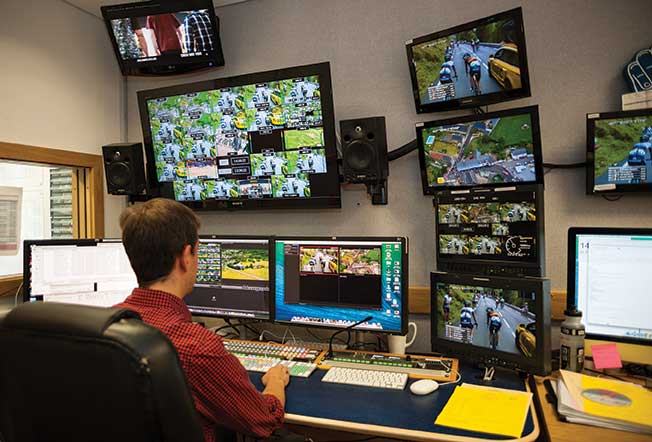
Cycle Of Life
Posted on Jan 7, 2015 by Alex Fice
Editors were routinely cutting the final segments of the four-part highlights show while the start of the show was being transmitted to air.
Recent FCP-X updates and the arrival of the new Mac Pro computers were timely for the latest Tour de France broadcast this summer. Four edit suites were primed to edit the programme before and while it aired.
VSquared (V2) is a production company that produces professional cycling programming for clients that include ITV, BBC, Channel 4, British Cycling, UCI and Locog. Most recently they created over 90 hours of content covering the Tour de France for the UK’s ITV network. For this project, V2 transitioned from a Final Cut 7 workflow to FCPX on new Mac Pro systems to help meet demanding daily production deadlines.
“Since the new Mac Pro systems require all of the interfacing to be done externally, we used AJA Io 4Ks to provide HD-SDI out for both video and audio monitoring in all of our edit suites,” explained James Venner, senior producer at V2. “The Io 4Ks performed flawlessly—they were easy to use and set up with connection to the Mac Pros via Thunderbolt 2, and we had no issues with lip sync on output of audio and video together. Once they were up and running, we didn’t have to think about them again.”
As the production company selected to produce the Tour de France programming for ITV, V2 was in production on-site for 21 days straight, developing both live and produced segments for broadcast. V2 had a team of 15 shooters and producers on site during the event in France, and another 15 back in London, where their editing setup and facility is based. For each day of the Tour, the team produced a live show and a highlights show that aired in the evening. The volume of content required very fast turnaround, and the team was usually editing the highlights show while footage from the day’s stage was still being ingested.
“We were routinely editing the final segments of the four-part highlights show while the start of the show was being transmitted to air,” explained editor Peter Wiggins. “The entire system allows us to feed the completed segments of the edited show down to the EVS in under five minutes, which was only made possible due to the computing power of the new Mac Pro. Our render times were reduced to almost nothing, and together with the Io 4Ks, this was a complete failure-proof workflow.”
Interview and ancillary content captured by V2 shooters on Sony XDCam cameras and official Tour de France race footage came in via satellite from France to London, and was recorded as Apple ProRes 422 files using Softron Movie Recorder software utilizing two AJA Io 4k units for ingest. These files were accessed by each of V2’s four edit suites, all equipped with a MacPro and Io 4K for HD-SDI output. Separately, AJA T-TAPs were used for playout from Mac Pro systems in Web editing suites to provide HD-SDI monitoring.
Charlie Tear is the Technical Director of Timeline Television, “We have been working with our clients V2 for several years (I think 2009 was the first time.) providing tapeless post-production facilities for live editing on ‘le Tour’.
“This is the third year that the Tour has been produced from our broadcast centre in Ealing.
 “Seeing 350 hours of archive material load and be viewable almost instantly in a single event browser was definitely an real ‘aha’ moment for me”. Charlie Tear, Timeline Television.
“Seeing 350 hours of archive material load and be viewable almost instantly in a single event browser was definitely an real ‘aha’ moment for me”. Charlie Tear, Timeline Television.
“The idea to move to FCPX was first raised by V2 late last year. It is clear that FCP7 is on borrowed time and V2 felt that there was an opportunity to be ahead of the curve and to help define the next generation of FCP workflow, rather than having to follow the lead of others next year. With recent releases of FCPX strengthening the software’s ability to be used in shared environments and some additional advances in software and hardware, both V2 and Timeline felt that this was an idea that could now be fully explored.
“After these initial meetings, we drew up a schedule for testing and developing various hardware and software configurations that would allow the same kind of live editing workflows that had become the norm for FCP7 for so many years. “These tests began in May this year and concluded just a few short days before the momentous Grand Depart of the 2014 Tour in Yorkshire.
“Several core technologies were tested, retested and tested again as device drivers, beta releases and version updates came and went, and we finally settled on a system that left the previous generation of Apple’s Mac Pro hardware behind and utilised the tremendous power of the new Mac Pro systems, for both edit and ingest.
“Our traditional edit-while-ingest solution is based upon EVS hardware, streaming media from an XT3 using Xsquare – but EVS’ support for advances in technology used by FCPX (or perhaps Apple’s support for EVS Quicktime files) is currently not workable. This guided us to MovieRecorder from Softron Media, which also runs on the Mac Pro hardware, recording the two incoming Multilateral and Unilateral feeds in ProRes 422, via an AJA Io 4K interface, to our 84TB Xsan storage. A second Mac Pro running MovieRecorder records the same feeds to a Promise Pegasus 2 R6 Thunderbolt RAID, for added resilience.
“The performance of the SSD storage inside these new machines comfortably exceeds that of the fibre–channel Xsan that now acts as shared storage. This makes exporting files almost unbelievably quick, which is a real consideration when working to such tight turnaround schedules. The bottleneck is now very much the gigabit Ethernet connection, which facilitates the transfer of the exported elements to the EVS for play out – we look forward to the 10GbE upgrade for our XT3 hardware to address that particular issue! Promise Pegasus M4 Thunderbolt drives are utilised to act as local scratch storage for each edit machine and AJA Io 4K Thunderbolt interfaces provide desktop monitoring and playout capability for the edits.
“V2’s relationship with Apple meant that we were able to call upon a great deal of support from the FCPX software team and we also enjoyed the benefit of working alongside freelance FCP guru Alex Snelling, who worked extremely hard developing and refining the editing and project workflow, to ensure that the organisation of the large amount of daily line feeds, project media, event libraries and so on would be built and managed in a effective way. Alex’s knowledge of FCPX is superb and he worked tirelessly to fine-tune the workflow, train the editors and organise V2’s huge archive of TDF material dating back many decades into a searchable online library.
 “The idea to move to FCPX was first raised by V2 late last year. It is clear that FCP7 is on borrowed time and V2 felt that there was an opportunity to be ahead of the curve”. Charlie Tear, Timeline Television.
“The idea to move to FCPX was first raised by V2 late last year. It is clear that FCP7 is on borrowed time and V2 felt that there was an opportunity to be ahead of the curve”. Charlie Tear, Timeline Television.
“Seeing 350 hours of archive material load and be viewable almost instantly in a single event browser was definitely an real ‘aha’ moment for me and it was then that the metadata-driven and highly hardware-optisimised power of FCPX really started to make sense. Apple have certainly heralded a new way of thinking about the NLE and the speed at which it is possible to call upon any of these archive assets, using a tag or keyword search is one area which really impressed.
“Overall it was a fairly tough schedule of testing and the lion’s share of the time was spent arriving on a solid combination of CPU hardware, local and shared storage, and software versions. A timely release of FCP X 10.1.2 arrived just before our decision deadline, and once the editors arrived for dry run, the system was responding well and the small matter of 32 days of close-to-air editing began in earnest! The first day was a baptism of fire – on air, with a completely new workflow, for over nine hours!”













